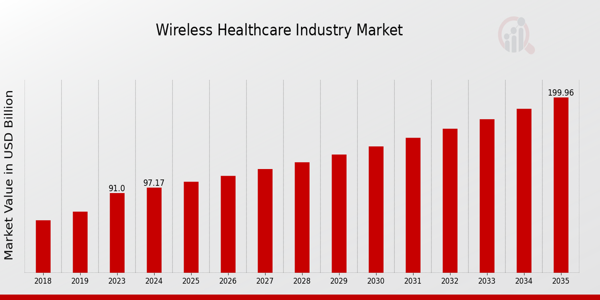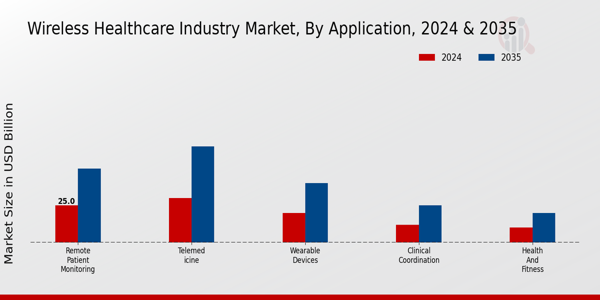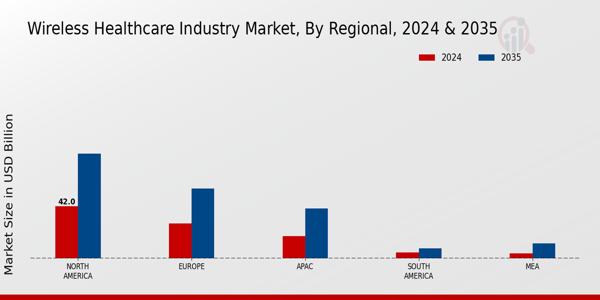Wireless Healthcare Market Overview
The Wireless Healthcare Market Size was estimated at 91.0 (USD Billion) in 2023.
The Wireless Healthcare Industry is expected to grow from 97.17 (USD Billion) in 2024 to 200.0 (USD Billion) by 2035. The Wireless Healthcare Market CAGR (growth rate) is expected to be around 6.78% during the forecast period (2025 - 2035).
Key Wireless Healthcare Market Trends Highlighted
The growing use of telemedicine and remote patient monitoring are two reasons propelling the wireless healthcare market's notable expansion. Other significant factors are the growing prevalence of chronic illnesses and the need for effective healthcare solutions.
Furthermore, improvements in wireless technology have made it simpler for medical professionals to provide better services, improving patient care and satisfaction.
Wireless solutions are becoming vital tools for practitioners seeking to maximize resources while maintaining patient safety as the focus on cost-effective healthcare delivery grows. In this changing environment, there are a lot of options to investigate.
Wearable devices and mobile health applications are gaining popularity, representing a chance for innovation in healthcare monitoring and data management. The integration of artificial intelligence and machine learning into wireless healthcare systems can enhance predictive analytics, leading to more personalized patient care.
Additionally, companies that focus on interoperability of health data systems are likely to thrive, as consolidation of data sources will provide valuable insights for both providers and patients. There is a rising awareness around mental health and increasing demand for wireless solutions designed to address these needs, presenting further avenues for market players.
Recent trends highlight the shift towards patient-centered care, with healthcare professionals increasingly adopting mobile health platforms. There is also a focus on improving user experience through intuitive interfaces and seamless connectivity options.
The COVID-19 pandemic has accelerated the acceptance of telehealth services, pushing healthcare systems to adapt quickly to a more digital approach. As healthcare continues to evolve in response to these changes, the importance of security and data privacy remains paramount, ensuring that patient trust is maintained.
The wireless healthcare market is set to continue its trajectory, driven by these trends and the ongoing demand for innovative healthcare solutions.

Source: Primary Research, Secondary Research, MRFR Database and Analyst Review
Wireless Healthcare Market Drivers
Advancements in Wireless Technology
The Wireless Healthcare Market is seeing remarkable growth due to rapid advancements in wireless technologies. The evolution of wireless communication standards, such as 5G and advanced Wi-Fi, has transformed the way healthcare services are delivered, making them more efficient and accessible.
Enhanced wireless communication enables real-time data sharing, remote monitoring, and telehealth services, which have become increasingly important in today's healthcare landscape. With the integration of the Internet of Things (IoT) and wearable devices in healthcare, patients can now be monitored continuously without the restrictions of wired systems.
This shift not only improves patient outcomes through timely interventions but also streamlines operations within healthcare facilities. As technology evolves, the capabilities of the Wireless Healthcare Market will expand further, fostering innovations in diagnostics and patient management.
Additionally, cost-effective implementation of wireless solutions drives healthcare providers toward adopting these technologies, as they lead to better resource allocation and improved patient satisfaction.
Overall, the advancements in wireless technology are paving the way for a more interconnected and responsive healthcare environment, significantly contributing to the growth of the Wireless Healthcare Market.
Increased Demand for Telehealth Services
The Wireless Healthcare Market is experiencing a surge in demand for telehealth services. This increase is attributed to growing consumer preferences for remote care, particularly accelerated by recent health crises.
Patients now prioritize convenience and accessibility in their healthcare experience, leading to a higher acceptance of virtual consultations and remote patient monitoring. As healthcare providers adapt to these shifting consumer expectations, the market for wireless healthcare solutions expands, with an emphasis on platforms that facilitate effective telehealth interactions.
This driver not only responds to patient needs but also supports healthcare systems in managing resource utilization more effectively.
Government Initiatives and Funding
Government initiatives and funding in many regions worldwide are driving the growth of the Wireless Healthcare Market. By investing in the development and integration of digital health solutions, governments are fostering environments that promote innovation and enhance healthcare delivery.
Policies aimed at improving access to technology and healthcare services support the adoption of wireless healthcare systems, encouraging stakeholders to embrace digital transformation. Such initiatives not only increase the availability of wireless technologies in healthcare settings but also stimulate research and development efforts, which further enhance the market's growth potential.
Wireless Healthcare Market Segment Insights
Wireless Healthcare Market Application Insights
The Wireless Healthcare Market witnessed considerable growth in the Application segment. The market experienced a significant transformation propelled by advancements in technology, increased smartphone penetration, and the growing demand for efficient healthcare solutions.
These factors contributed to the overall development of market growth that encompasses diverse applications aimed at improving patient care and healthcare delivery.
Among the various applications, Remote Patient Monitoring held a prominent position, valued at 25.0 USD Billion in 2024. This segment benefited from the increasing prevalence of chronic diseases and the need for continuous care, offering healthcare providers the ability to monitor patients remotely, thereby reducing hospital visits and enhancing patient outcomes.
Telemedicine was another crucial application in this segment, valued at 30.0 USD Billion in 2024, capitalizing on the necessity for innovative consultation methods, particularly evident during health crises. This application facilitated virtual consultations and improved access to medical expertise, ultimately broadening patient reach.
Wearable Devices were also becoming increasingly significant, with a market valuation of 20.0 USD Billion in 2024, driven by rising consumer awareness of personal health management and advancements in sensor technology. These devices played a crucial role in collecting real-time health data, assisting individuals in monitoring fitness levels and encouraging healthy lifestyles.
Clinical Coordination, valued at 12.0 USD Billion in 2024, was essential in streamlining communication between various healthcare professionals, thereby improving patient care and operational efficiency within healthcare systems.
Lastly, the Health and Fitness application, despite being smaller in size, valued at 10.17 USD Billion in 2024, gained traction as people increasingly focus on preventive healthcare and wellness; this application promotes an active lifestyle through technology.
Together, these applications were contributing to the evolution of the Wireless Healthcare Market, offering numerous opportunities for innovation and improved health outcomes, thus shaping future trends in the industry and enhancing overall patient engagement and satisfaction.
With the projected growth, the segmentation of the market underscored the diverse range of solutions that cater to the needs of the healthcare ecosystem, showcasing the importance of each application in enhancing the effectiveness of healthcare delivery.

Source: Primary Research, Secondary Research, MRFR Database and Analyst Review
Wireless Healthcare Market Technology Insights
The Wireless Healthcare Market showcases the importance of technology in transforming healthcare delivery. This market has shown consistent growth driven by the adoption of advanced communication technologies facilitating remote patient monitoring and real-time health data access.
The segments within this market include Wireless Sensor Networks, Bluetooth Technology, Near Field Communication, Wi-Fi Technology, and Cellular Technology, each playing a crucial role in enhancing connectivity in healthcare settings.
Wireless Sensor Networks are pivotal in connecting medical devices to collect data efficiently, while Bluetooth Technology has revolutionized personal health monitoring, providing user-friendly interfaces for clinicians and patients alike.
Near Field Communication facilitates quick and secure data exchange, contributing to streamlined patient care processes. Wi-Fi Technology maintains robust network infrastructure ensuring seamless access to health information systems in hospital environments. Meanwhile, Cellular Technology supports wide-area communications, essential for remote patient management.
Together, these technologies reflect significant trends indicating a shift towards more integrated, patient-centric healthcare solutions, underlining the potential for further growth in the Wireless Healthcare Market.
Wireless Healthcare Market End Use Insights
Within this market, the End Use segment encompasses various critical areas such as Hospitals, Home Care, Diagnostic Centers, Ambulatory Surgical Centers, and Pharmaceutical Companies. Hospitals represent a significant portion of the market, leveraging advanced wireless technologies to enhance patient monitoring and care efficiency.
Meanwhile, the Home Care sector is gaining traction as consumers increasingly prefer receiving medical services in the comfort of their homes, a trend that is driving notable growth. Diagnostic Centers play a vital role by integrating wireless solutions for improved diagnostic capabilities, making them essential to the market's dynamics.
Ambulatory Surgical Centers are also notable contributors, as they utilize wireless healthcare solutions to optimize surgical workflows and patient management. Additionally, Pharmaceutical Companies benefit from wireless technologies for better drug delivery and patient compliance monitoring.
The need for innovative solutions across these areas fuels the overall market growth, as evidenced by Wireless Healthcare Market data reflecting a significant demand for enhanced healthcare services and technologies.
The projected market growth is supported by an evolving healthcare landscape that prioritizes accessibility and efficiency, creating numerous opportunities for stakeholders engaged in wireless healthcare advancements.
Wireless Healthcare Market Product Type Insights
Within this segment, various categories play a crucial role in shaping market dynamics. Wearable Monitors have gained traction due to their ability to offer real-time health tracking, making them vital for both patients and healthcare providers.
Mobile Health Applications are also significant, as they enhance accessibility and personal engagement in healthcare management. Healthcare Communication Devices facilitate essential interactions in a timely manner, proving their critical importance in patient care.
Meanwhile, Healthcare Management Software ensures efficient administrative processes, significantly improving operational efficiencies. Lastly, Remote Monitoring Platforms dominate the landscape by allowing healthcare professionals to monitor patients from afar, which enhances patient safety and reduces the need for frequent hospital visits.
This diverse array of products illustrates the comprehensive nature of the Wireless Healthcare Market segmentation, each contributing uniquely to the industry’s overall growth and functional advancements.
Wireless Healthcare Market Regional Insights
The Regional analysis of the Wireless Healthcare Market revealed significant insights regarding value distribution across various areas. In 2024, North America showed a dominant presence with a valuation of 42.0 USD Billion, expected to reach 84.0 USD Billion by 2035, highlighting its majority holding in the market due to advanced healthcare infrastructure and high adoption of wireless technologies.
Following this, Europe was valued at 28.0 USD Billion in 2024, with projections of 56.0 USD Billion in 2035, driven by increasing healthcare investments and technological advancements.
The Asia-Pacific (APAC) region, valued at 18.0 USD Billion, was also notable, reflecting a growing trend in adopting wireless healthcare solutions, particularly in emerging economies, and is expected to reach 40.0 USD Billion by 2035.
In contrast, South America, while smaller at 5.0 USD Billion, is projected to grow to 8.0 USD Billion, indicating emerging opportunities in its healthcare sector. The Middle East and Africa (MEA) segment, starting at 4.17 USD Billion, showed potential growth to 12.0 USD Billion, largely due to rising demand for healthcare accessibility.
Overall, the Wireless Healthcare Market data illustrated a robust growth potential across these regions, fueled by increasing demand for efficient healthcare solutions and technological integration.

Source: Primary Research, Secondary Research, MRFR Database and Analyst Review
Wireless Healthcare Market Key Players and Competitive Insights
The Wireless Healthcare Market is an evolving sector characterized by the integration of technological advancements aimed at enhancing patient care and operational efficiencies.
The competitive landscape is marked by a multitude of players ranging from established technology firms to specialized healthcare providers and startups that are innovating in telehealth, remote monitoring, and mobile health applications.
The rapid adoption of wireless technologies in healthcare delivery is driven by the increasing demand for efficient healthcare systems, the growing prevalence of chronic diseases, and the need for better patient engagement and accessibility.
Companies within this market are focusing on research and development to introduce advanced solutions that improve quality care while reducing costs, thereby fostering a robust competitive environment where innovation is key to capturing market share.
Abbott Laboratories holds a formidable position in the Wireless Healthcare Market, leveraging its extensive portfolio of healthcare solutions and innovations. With a strong emphasis on diagnostics and health management tools, Abbott Laboratories has developed a range of wireless monitoring devices that provide real-time data collection and analysis to improve patient outcomes.
The strength of Abbott Laboratories lies in its commitment to research and development, allowing for continuous improvements in existing offerings and the development of new technologies.
Moreover, Abbott’s strategic partnerships and collaborations further enhance its market presence by expanding its reach and integrating wireless solutions within various healthcare frameworks, ensuring that patients and providers can experience seamless connectivity and more effective management of health conditions.
GE Healthcare is another significant player in the Wireless Healthcare Market, known for its dedication to advancing health through innovative technologies and solutions. The company has been at the forefront of developing integrated healthcare systems that utilize wireless technologies to facilitate data sharing and clinical decision support.
GE Healthcare harnesses the power of big data and analytics in its wireless solutions, enhancing diagnostic accuracy and optimizing patient flow in hospitals and outpatient settings. Recognized for its strong emphasis on innovation, GE Healthcare continually invests in research and technical advancements which strengthen its competitive edge in the market.
The ability to provide advanced imaging and monitoring solutions tailored for diverse medical environments underpins GE Healthcare’s strategy, garnering trust from healthcare providers and ensuring efficient patient care delivery throughout the industry.
Key Companies in the Wireless Healthcare Market Include
- Abbott Laboratories
- GE Healthcare
- IBM
- Qualcomm
- SAP
- Oracle
- Philips
- Cerner Corporation
- Siemens Healthineers
- Fujifilm
- Honeywell
- Cisco Systems
- Epic Systems
- Medtronic
- Johnson and Johnson
Wireless Healthcare Market Developments
Recent developments in the Wireless Healthcare Market have showcased significant advancements and shifts among major companies such as Abbott Laboratories, GE Healthcare, and IBM. These organizations are increasingly investing in digital health technologies, particularly remote patient monitoring and telehealth solutions, driven by rising demand for efficient healthcare delivery.
Qualcomm continues to innovate in wireless communication technologies tailored for healthcare, while SAP and Oracle focus on integrated healthcare data systems to enhance operational efficiencies. Philips and Cerner Corporation are advancing their capabilities in data analytics, which are essential for improving patient outcomes.
Significant merger activities were witnessed where organizations like Siemens Healthineers and Fujifilm are consolidating their operations to strengthen market presence. Honeywell and Cisco Systems are also forming strategic partnerships to leverage IoT in healthcare applications.
Market valuations have observed considerable growth, largely attributed to increased smartphone penetration and a shift towards value-based care models, compelling various stakeholders to explore cutting-edge wireless solutions.
As the dynamic landscape evolves, firms like Medtronic and Johnson & Johnson are positioning themselves to capitalize on these trends, thus urging continuous adaptation to meet the burgeoning demands.
Wireless Healthcare Market Segmentation Insights
Wireless Healthcare Market Application Outlook
- Remote Patient Monitoring
- Telemedicine
- Wearable Devices
- Clinical Coordination
- Health and Fitness
Wireless Healthcare Market Technology Outlook
- Wireless Sensor Networks
- Bluetooth Technology
- Near Field Communication
- Wi-Fi Technology
- Cellular Technology
Wireless Healthcare Market End Use Outlook
- Hospitals
- Home Care
- Diagnostic Centers
- Ambulatory Surgical Centers
- Pharmaceutical Companies
Wireless Healthcare Market Product Type Outlook
- Wearable Monitors
- Mobile Health Applications
- Healthcare Communication Devices
- Healthcare Management Software
- Remote Monitoring Platforms
Wireless Healthcare Market Regional Outlook
- North America
- Europe
- South America
- Asia Pacific
- Middle East and Africa
| Report Attribute/Metric |
Details |
| Market Size 2023 |
91.0(USD Billion) |
| Market Size 2024 |
97.17(USD Billion) |
| Market Size 2035 |
200.0(USD Billion) |
| Compound Annual Growth Rate (CAGR) |
6.78% (2025 - 2035) |
| Report Coverage |
Revenue Forecast, Competitive Landscape, Growth Factors, and Trends |
| Base Year |
2024 |
| Market Forecast Period |
2025 - 2035 |
| Historical Data |
2019 - 2024 |
| Market Forecast Units |
USD Billion |
| Key Companies Profiled |
Abbott Laboratories, GE Healthcare, IBM, Qualcomm, SAP, Oracle, Philips, Cerner Corporation, Siemens Healthineers, Fujifilm, Honeywell, Cisco Systems, Epic Systems, Medtronic, Johnson and Johnson |
| Segments Covered |
Application, Technology, End Use, Product Type, Regional |
| Key Market Opportunities |
Telemedicine adoption growth, Remote patient monitoring demand, Wearable health tech innovations, AI-driven data analytics, Integration of IoT devices |
| Key Market Dynamics |
Increasing demand for remote monitoring, Advancements in wearable technology, Rising investment in healthcare IoT, Growing focus on preventive care, Regulatory support for digital health |
| Countries Covered |
North America, Europe, APAC, South America, MEA |
Frequently Asked Questions (FAQ) :
The market size of the Wireless Healthcare Market in 2024 was valued at 97.17 USD Billion.
By 2035, the Wireless Healthcare Market is expected to reach a value of 200.0 USD Billion.
The projected CAGR for the Wireless Healthcare Market from 2025 to 2035 is 6.78%.
North America held the largest market value in 2024 at 42.0 USD Billion.
The Remote Patient Monitoring application segment is expected to be valued at 50.0 USD Billion in 2035.
The market size for Telemedicine in 2024 was valued at 30.0 USD Billion.
Key players in the Wireless Healthcare Market include Abbott Laboratories, GE Healthcare, IBM, and Qualcomm among others.
The market size of the Wearable Devices application segment is expected to reach 40.0 USD Billion by 2035.
The expected market value for Europe in 2035 is projected to reach 56.0 USD Billion.
The projected growth rate for the South American region indicates it will grow from 5.0 USD Billion in 2024 to 8.0 USD Billion by 2035.

















